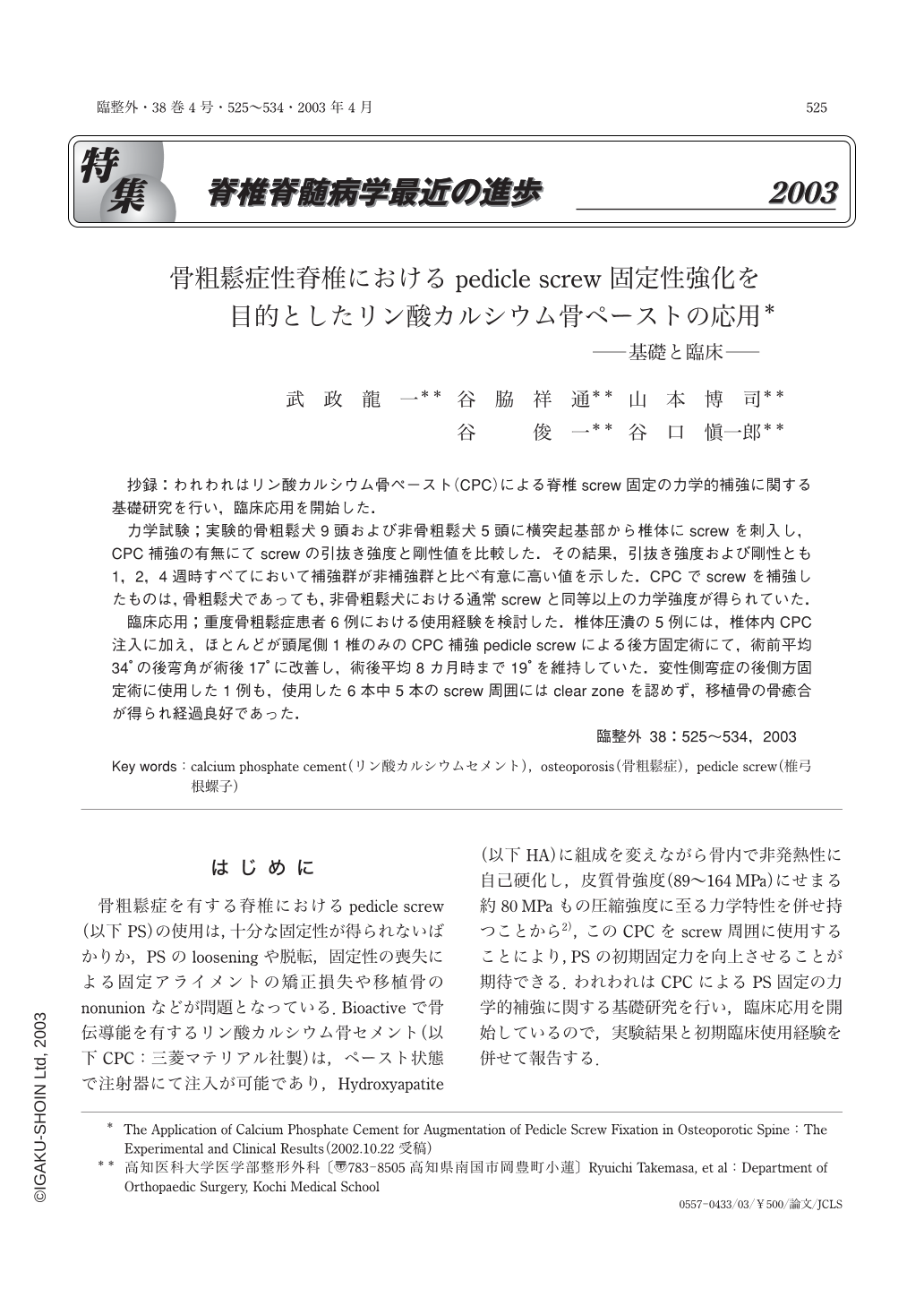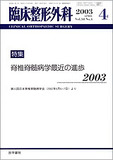Japanese
English
- 有料閲覧
- Abstract 文献概要
- 1ページ目 Look Inside
抄録:われわれはリン酸カルシウム骨ペースト(CPC)による脊椎screw固定の力学的補強に関する基礎研究を行い,臨床応用を開始した.
力学試験;実験的骨粗鬆犬9頭および非骨粗鬆犬5頭に横突起基部から椎体にscrewを刺入し,CPC補強の有無にてscrewの引抜き強度と剛性値を比較した.その結果,引抜き強度および剛性とも1,2,4週時すべてにおいて補強群が非補強群と比べ有意に高い値を示した.CPCでscrewを補強したものは,骨粗鬆犬であっても,非骨粗鬆犬における通常screwと同等以上の力学強度が得られていた.
臨床応用;重度骨粗鬆症患者6例における使用経験を検討した.椎体圧潰の5例には,椎体内CPC注入に加え,ほとんどが頭尾側1椎のみのCPC補強pedicle screwによる後方固定術にて,術前平均34°の後弯角が術後17°に改善し,術後平均8カ月時まで19°を維持していた.変性側弯症の後側方固定術に使用した1例も,使用した6本中5本のscrew周囲にはclear zoneを認めず,移植骨の骨癒合が得られ経過良好であった
We report our experimental data and clinical results for augmentation of pedicle screw fixation with calcium phosphate cement (CPC) in the osteoporotic spine. In an in-vivo experimental study, CPC significantly enhanced both the stiffness and pull-out strength of the screws in a canine model of osteoporosis, 1, 2, and 4 weeks after screw insertion. Pull-out strength was enhanced by CPC immediately after screw insertion, and it significantly increased over time. The pull-out strength of the CPC-augmented screws in the osteoporotic dogs was significantly higher at all times tested than that of the non-augmented screws in non-porotic dogs, although stiffness was within the same range at all times tested in both groups. The results in this experimental study suggested that the CPC might enhance pedicle screw fixation clinically.
In the clinical study, we augmented pedicle screw fixation with CPC in 5 cases of osteoporotic vertebral pseudarthrosis with severe kyphotic deformity and in 1 case of lumbar degenerative scoliosis. All patients had grade 3 severe osteoporotic bone atrophy according to the Jikei University grading system. In the vertebral pseudarthrosis cases, posterior short segmental fusion with the CPC-augmented pedicle screw was performed in combination with CPC vertebroplasty to repair pseudarthrosis and provide anterior column support. The average kyphosis angle of the fused segment was 34° preoperatively, and was corrected to 17° immediately after surgery. Correction was maintained at as much as 19° as of the final follow-up at an average of 8months. Back pain resolved immediately after surgery, and fusion was achieved in all patients without any complications. In-situ fusion was achieved in the degenerative scoliosis case, and the clinical course was rated satisfactory. No radiolucent zone around 5 of the 6 pedicle screws has been observed.The clinical results confirmed the promising results obtained in the experimental study.

Copyright © 2003, Igaku-Shoin Ltd. All rights reserved.


